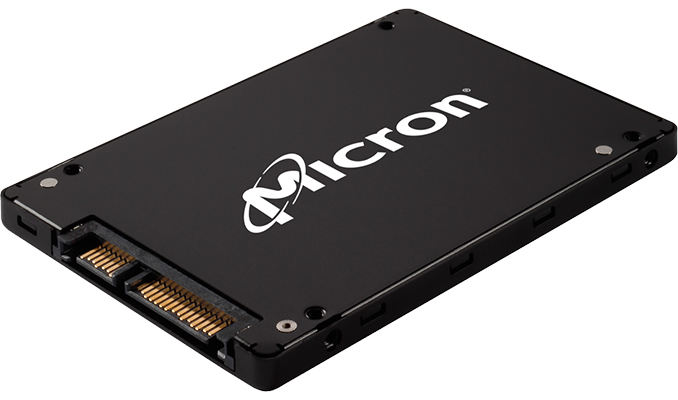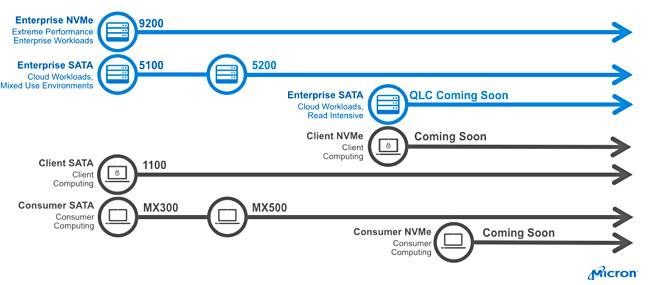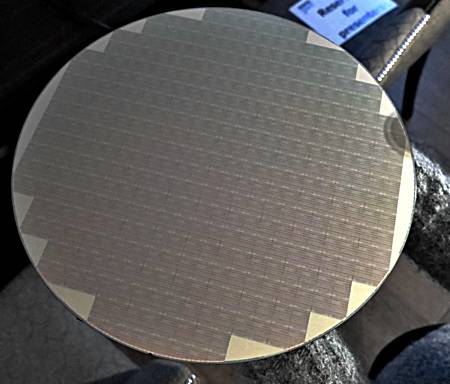Micron Readies 3D QLC NAND-Based Datacenter SSDs for Nearline Storage
by Anton Shilov on February 12, 2018 3:00 PM EST
Micron has revealed plans to release datacenter-class SSDs based on 3D QLC NAND memory in an effort to compete in the nearline storage market. Briefly announced at a conference last week, the company is taking aim at applications that currently use 7200 RPM HDDs, the use of which is increasingly common in nearline storage. The manufacturer did not reveal any additional details about the upcoming drive, but demonstrated a wafer with QLC 3D NAND dies.
Micron disclosed its plans concerning own-brand SSDs in 2018 at the A3 Technology Live conference in London last week. Among other things, the company intends to introduce a QLC-based SSD with a SATA interface for cloud datacenters this year. The drive will be positioned below the existing 5200-series SSDs and will be aimed primarily at read intensive applications (or the so-called WORM — write once, read many workloads). The QLC-based SSD will have a feature set aimed at hyperscale datacenters and will compete for the place currently occupied by high-capacity 7200 RPM HDDs, reports The Register.
The manufacturer did not disclose capacity of the upcoming QLC-based drives and did not reveal whether they will feature in-house developed controllers with enhanced ECC capabilities (developed using IP and engineers the company got when it acquired Tidal Systems several years ago), or third-party enterprise-grade controllers. The company demonstrated a wafer carrying 64 GB (i.e., 512 Gb) 3D QLC NAND chips, indicating that it has the new flash memory at hand already.
QLC flash memory stores four bits per cell, thus offering a 33% higher bit density and lower per-bit cost compared to TLC flash commonly used for high-capacity SSDs today. 3D QLC NAND has been formally announced by Toshiba and Western Digital so far, but there are no doubts that all producers of NAND are working on QLC chips too. Increasing the bit density of NAND flash usually comes at the cost of endurance, but Toshiba last year said that it had managed to increase endurance of its 3D QLC NAND flash to 1000 program/erase cycles by using a stronger ECC mechanism, which is comparable to endurance of 3D TLC NAND.
QLC’s higher bit densities as well as lower per-bit costs are expected to reduce per-GB prices of high-capacity SSDs further and enable them to compete against existing leading-edge HDDs, such HGST’s Ultrastar with 12 or 14 TB capacity. Two obvious advantages that high-capacity QLC-based SSDs will have when compared to hard drives are lower latencies and higher storage densities. Meanwhile, per-GB costs of HDDs will remain lower when compared to NAND flash for years to come — this is what producers of both HDDs and flash memory agree on. So I'd expect to see that these upcoming 3D QLC NAND-based SSDs will sit between high-capacity HDDs and high-performance SSDs, occupying a tier of their own in hyperscale datacenters.
Related Reading:
- Western Digital Announces Four Bit Per Cell 64-Layer 3D NAND Flash
- Toshiba's 768Gb 3D QLC NAND Flash Memory: Matching TLC at 1000 P/E Cycles?
- Micron 2017 Roadmap Detailed: 64-layer 3D NAND, GDDR6 Getting Closer, & CEO Retiring
- Micron 3D NAND Update: 2D and 3D NAND Bit Crossover, Gen 2 Hits Production












29 Comments
View All Comments
close - Tuesday, February 13, 2018 - link
Then they'll assume MLC is mono-level cell.When it comes to marketing people any good argument will fly over their heads.
saratoga4 - Monday, February 12, 2018 - link
>Calling it multi-level doesn't make any sense with triple and quad-level NAND around.None of the name make any sense, since "triple level" actually has 8 levels, and "quad level" actually has 16 levels. They should have just gone with "2/3/4 bit per cell".
shabby - Monday, February 12, 2018 - link
Everyone knows mlc is dual level nand, i mean no one in their right mind would try to pass off qlc as mlc... right?Holliday75 - Monday, February 12, 2018 - link
I am getting a headache from reading these posts.Kristian Vättö - Tuesday, February 13, 2018 - link
Some vendors are using 3bit and 4bit MLC names.danielfranklin - Monday, February 12, 2018 - link
Does the thought of these QLC chips bring on a shudder of fear in anyone else?Yes they are starting at enterprise and thats fine, but you know these are going to end up in consumer SSDs, the Micron chips always do.
This is not going to be understood by 98% of the market.
OEMs will fill their laptops with them, retailers will be selling them at competitive prices.
We saw so much bad TLC flood the market early on and while i give it to them that its got a lot better, anyone who knows quite how bad QLC will be should be quite worried.
I guess in a flash filled future there are simply going to be many grades of it in existence, unfortunately we just too often see a race to the bottom....
dromoxen - Tuesday, February 13, 2018 - link
These do not fill me with dread , as long as they can keep the write amplification down, a feat I think they are perfecting from knowledge of 3bit cell. . Chips are getting smaller, and cheaper so yes all flash desktop PC, for everyone, should be here in 2020FunBunny2 - Tuesday, February 13, 2018 - link
"Chips are getting smaller, and cheaper "recall that old dodge: "if you step halfway to the wall, how many steps does it take to get to the wall?" we're within cite of Heisenberg NAND. not something I'm thrilled about.
PeachNCream - Tuesday, February 13, 2018 - link
Like Heisenberg blimp NAND? Oh the huge manatee!BurntMyBacon - Thursday, February 15, 2018 - link
@dromoxen: "Chips are getting smaller, and cheaper so yes all flash desktop PC, for everyone, should be here in 2020"Do you really think a ~20% price reduction at the same capacity vs a TLC drive is going to be the tipping point here? I think better stacking, which helps TLC and even MLC as well, is playing a bigger role here.